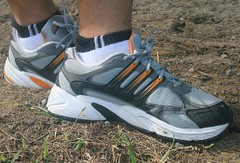Thrombocytes are actually not true cells. They are fragments of cytoplasm from certain bone marrow cells. Together with fibrin, they play a very important role in BLOOD CLOTTING. Blood clotting is very important because it helps to seal wound and cut, thus preventing excessive loss of blood. Apart from this it also stops foreign particles like bacteria from entering the blood stream.
The following figure shows how blood clot clogged wound thus preventing blood loss.
MECHANISM OF BLOOD CLOTTING
The following figure shows how blood clot clogged wound thus preventing blood loss.

MECHANISM OF BLOOD CLOTTING
- At cut or wound, an enzyme called thrombokinase is released by the damaged tissues and blood platelets.
- The thrombokinase together with calcium ions, then convert the (inactive) protein prothrombin to thrombin (Calcium ions as well as vitamin K must be present, otherwise blood clotting will not take place - hence one of the importance role of calcium in your diet).
- The thrombin (which is also an enzyme) then catalyses the conversion of soluble protein fibrinogen to a meshwork of insoluble threads of fibrin.
- The fibrin threads formed entangle the red blood cells which results in the formation of BLOOD CLOT. White blood cells can also be found together with the blood clot to fight against foreign particles like bacteria at the cut or wound.
The following figures show how the fibrin entangle the red blood cells to form BLOOD CLOT.


The following figure summarises the mechanism of blood clotting. It heps a lot if you remember the flow.

Vitamin K? Where is Vitamin coming from? It is actually produced by bacteria (NOT HARMFUL!!!) in your intestines.
